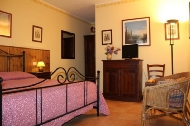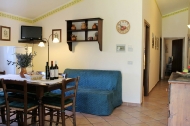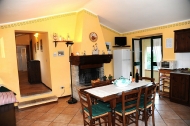La Fonte
Bevagna (Perugia) Code
Profile
In brief
- Type: Flat (4),
- Guests: 17
- Map: Hills
- Type of accommodation: Room only
The agriturismo
The farm offers guests an ideal holiday for those who want peace and quiet and want to enjoy the historical and priceless artistic treasures that the surrounding area offers.
(Translated with DeepL Translate)
The accommodation
In Bevagna, in the heart of Umbria, on the Sagrantino road is the Azienda Agricola la Fonte. The farm offers guests an ideal holiday for those who want peace and quiet and want to enjoy the historical and priceless artistic treasures that the surrounding area offers. The farmhouse, with panoramic views over the valley of Mount Subasio, on whose slopes rise Assisi and Spello, consists of four apartments, renovated with the love and taste of those who know this land, furnished in a cozy and equipped with every comfort. The Agriturismo has a private swimming pool, barbecue, shaded parking space and an outdoor veranda with pergola for each apartment, in addition to free Wi-Fi. Inside the private fenced property, of about 25 hectares, made up of olive groves, vineyards and woods, it is possible to go for walks and mountain bike excursions, if you are lucky to meet small wild animals such as squirrels, porcupines, hares and buzzards. If you wish, you can participate in agricultural work such as the grape and olive harvest. Moreover, you can taste the excellent wines produced by the farm, including the famous Sagrantino wine, and the exceptional extra virgin olive oil. Bevagna is a town in the province of Perugia in Umbria, once known for the fine paintings that were produced there, so much so that they are called "bevagne". It is included among the most beautiful villages in Italy. Roman town hall (Mevania) knew prosperity during the imperial age. Roman vestiges (the theatre, the thermal baths with valuable mosaics, the remains of a 2nd century A.D. temple and a Roman Domus) and suggestive medieval architecture contribute to make a visit to this urban centre pleasant. Among the most important monuments are the Palazzo dei Consoli, dating back to 1270, which currently houses the Teatro Torti; Piazza Silvestri which is one of the most important medieval squares in the region where the Church of San Michele, built towards the end of the 12th century, and the Church of San Silvestro, completed in 1195. In the municipal museum there are paintings of the Umbrian school and valuable sculptures. Every year, in the last decade of the month of Giungo, Bevagna returns to being the ancient medieval town. The Mercato delle Gaite (old name of the city quarters) proposes parades, competitions and elaborations of recipes of the traditional cuisine in the classic "Taverne"; everything relives in the suggestion of the period costumes that the citizens dress with festive and casual habit.
Activities and surrounding
Those who wish can participate in agricultural work such as the grape and olive harvest. In addition, you can taste the excellent wines produced by the company, including the famous Sagrantino wine, and the exceptional extra virgin olive oil. Bevagna is a town in the province of Perugia in Umbria, once known for the fine cloths that were produced there, so as to be called "bevagne". It is included among the most beautiful villages in Italy. Roman municipality (Mevania) experienced prosperity during the imperial era. Roman vestiges (the theatre, the thermal baths with valuable mosaics, the remains of a temple of the II century A.D. and of a Roman Domus) and suggestive medieval architectures contribute to make a visit to this urban centre pleasant. Among the most important monuments are the Palazzo dei Consoli, dating back to 1270, which currently houses the Teatro Torti; Piazza Silvestri which is one of the most important medieval squares in the region where you can find the Church of San Michele, built in the late twelfth century and the church of San Silvestro completed in 1195. In the municipal museum there are paintings of the Umbrian school and valuable sculptures. Every year, in the last ten days of the month of June, Bevagna returns to being the ancient medieval town. The Market of the Gaite (the old name of the town quarters) proposes again parades, competitions and elaborations of recipes of the traditional cuisine in the classical "Taverne"; everything lives again in the suggestion of the period costumes that the citizens dress with festive and nonchalant custom.
(Translated with DeepL Translate)
Services
Available services
Pets allowed
- Dogs
- Cats
Size/gender of dogs
- Small (under 10 kg)
- Medium (10 kg - 25 kg)
- Large (25 kg - 45 kg)
Allowed in
- Accommodation
- Public areas
- Outdoor picnic area
- Bike rental
- Nature Reserves
- Museums and galleries
- Artistic and historical sites
- Hiking
- Bird watching
- Fishing
- Horse riding
- Tennis
- Shopping



